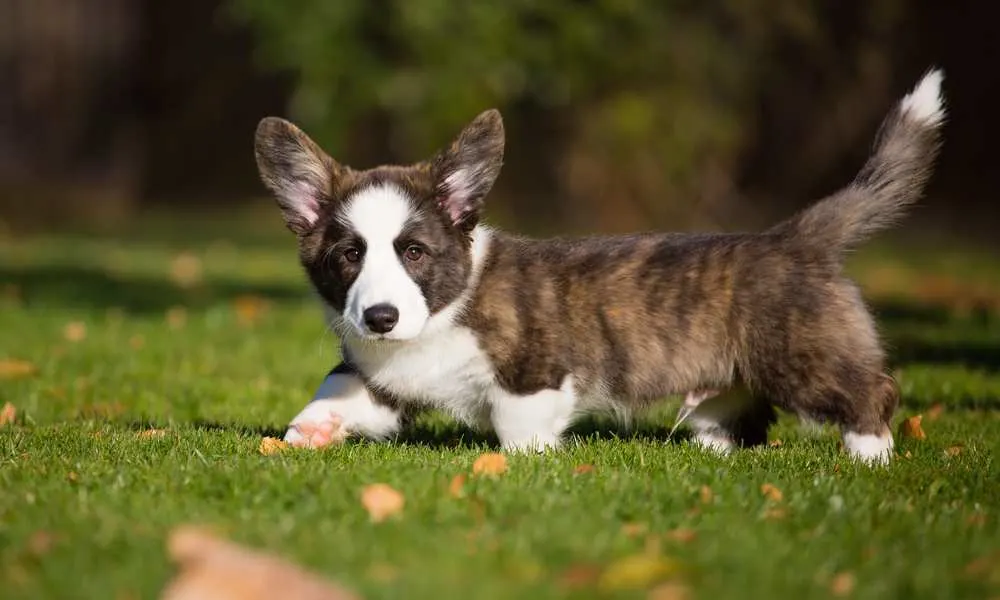Welsh Corgi Mythology and Folklore
Legend has it that the Welsh Corgi is the “enchanted” dog of the Fay. They were used by fairies and elves to pull their coaches or to serve as the steeds for their warriors. At night, the Welsh Corgi would slip away to the hills of Wales to play with the magical little people.
It is said that those who have an understanding heart, and a sharp eye, can see the faint fairy saddle on the back of a Welsh Corgi and the harness marks on their shoulders.

Naming the Corgi
There are numerous theories as to where the word “Corgi” comes from. The first is that the name “Corgi” derives from the Celtic word for “dog.”
Another theory is that the word “Corgi” is a mesh of the Welsh words, “cor” for “dwarf” and “ci” for “dog.” The latter half of the word, “ci” became “gi” which resulted in the word “Corgi.”
The word “Corgi” meant “dwarf dog” in Welsh. Another theory of how the word “Corgi” came about is that it came from the English words “cur dog” or “Cur” as it is referred to from Wyllam Salesbury’s “A Dictionary in Englyshe and Weslhe” London, 1574. In this dictionary, there is a reference to the “Korgi ne gostoc”, that is, Corgi or curre dogge. At the time, the letter K was interchangeable with the letter C.
Based on historical support, there is a connection between the words “Corgi” and “Cur.” Indeed, there are many references to Corgwn, which is the plural form of Corgi and is pronounced Corg’n like oxen, in many songs of praise in the 14th and 15th centuries.
However, that is not to say that the term Cur was a bad thing. Back then, the term Cur simply meant a dog of low breeding. It was used as a distinction between a working type of dog used by farmers and the kind of dog used for sporting and luxury used by the upper-class, like a lady’s lap dog.

The History of Welsh Corgis
Welsh Corgis have a long and rich history. There are a number of theories as to how the Corgi came to Wales. They may have been taken to Wales by the Vikings in the 800s or the Celts in about 1200 BC. Yet another theory is that it may be that the Flemish weavers took them in the 1100s.
The Corgi was originally bred to go before a herd of cattle and clear the way for them by chasing off potential predators and trespassing herds, and providing an area for grazing. It was only later that the Corgi began to act as a herder, working behind the cattle and directing the cattle from the Welsh farms to the English markets by barking and nipping at the cattle’s heals, his low stature helping his role by allowing him to get out of the way when a cow kicked. This was perhaps the time when the original Corgi was crossed with local sheepdogs.
The Welsh Corgi was also used to guard and collect domestic fowls. The Corgi could guard free roaming fowl against predators as well as gather the flock together so that they could be housed for the night. Corgis worked in teams along roads to drive flocks of large geese to the market. They were fairly silent workers, quiet enough that they would not make too much noise that would otherwise scatter the flock. They were also strong willed enough to control any goose that lagged behind or strayed.
Corgis excelled at the task of being market dogs, driving groups of livestock to the market. They are able to manage all different sorts of livestock, from domestic fowl to cattle to pigs.
Perhaps due to the crossbreeding with the local sheepdog, the Corgi was nonetheless a very versatile dog: acting as a cattle dog, market dog, family guardian and pet, as well as a vermin exterminator. They could be used for many different tasks on the farm. However, they were not as suitable as a sheep herder when compared to collies because they were supposedly too sharp and excitable for sheep.

Corgis were also used as gun dogs for both feather and fur animals as well as efficient ratters. Today, they are more commonly kept as companion dogs. The days of herding and driving for the Corgi are practically gone though some owners have continued to train their Corgis to herd livestock.
Corgis were not recognized as a purebred breed in the United Kingdom until the 1920’s. This was around the same time when the term “Corgi” was beginning to be used regularly and the time when any significant breed history was documented about these dogs.
While it has been known for quite a while that there were two different types of the Welsh Corgi, it has only been the past 70 or so years that this has been made official. The two breeds, Pembroke and Cardigan, have officially been known as two separate breeds since 1934 by the English Kennel Club and in 1935 by the American Kennel Club (AKC).
Prior to 1934, there were considered one breed and the two breeds were often freely interbred. It wasn’t until the 1930’s that breeders tried to separate the two breeds by accentuating their differences. In 1934, 250 Pembroke Welsh Corgis were registered in the English Kennel Club compared to only 59 Cardigans.
Today, both breeds of the Welsh Corgi are considered on the vulnerable list according to the English Kennel Club. The population of purebred Welsh Corgis has been declining in the UK, mostly due to the rising popularity of foreign breeds like the shih tsus, small toy breeds like the chihuahua, and crossbreeds like the labradoodles.
A breed is put on the vulnerable list when less than 100 purebred puppies are registered with the Kennel Club that year since a birthrate of 300 puppies a year is needed to guarantee a large gene pool and a healthy population.

History of Cardigan Welsh Corgis
The Cardigan Welsh Corgi, more commonly known as the Corgi with the tail, is the older of the two Corgi breeds. It is one of the earliest breeds in the British Isles, thought to have been in existence in Wales for over 3,000 years. The Cardigan Welsh Corgi is descended from the Teckel family of dogs, the same family of dogs that produced the Dachshund.
The Cardigan Corgi was brought in its uniquely elongated form by the Celtic tribes who migrated to Cardiganshire, Wales from central Europe in about 1200 B.C.. This early dog brought over by the Celtic tribes was a transitional form between the Teckel and the Spitz families. The Cardigan Welsh Corgi of today can be traced back to the old Bronant Corgi, with a slight infusion of the brindle herder blood.
Mrs. Robert Bole of Boston was the first bring to the United States a pair of Cardigan Welsh Corgis in June 1931. The Cardigan Welsh Corgi breed was admitted for the American Kennel Club registration in 1935. Currently, the Cardigan Welsh Corgi is not as popular as the Pembroke Welsh Corgi, their smaller cousin. However, they can still be found throughout many homes in the United States and the United Kingdom as a close household pet.

History of Pembroke Welsh Corgis
The Pembroke Welsh Corgi is known as the younger of the two Corgi breeds and is commonly known as the Corgi without the tail. They are also the more popular of the two Corgi breeds. While the Pembroke Welsh Corgi can be traced back to 1107 to the time of King Henry I of England, it remains heavily debated as to exactly which breed of dogs they are descended from.
One theory is that they are descended from the Vallhunds, Swedish cattle dogs that were thought to have been brought over to Pembrokeshire, Wales by the Vikings during the Viking invasion of 1,000 years ago.
Another theory, the one that is generally more supported, is that they are from the ancestors of the present-day Schipperkes and Pomeranians, Spitz-type dogs that were brought to Wales by Flemish weavers. These Flemish weavers had been induced by Henry I of England to move to Wales. It is thought that perhaps these Spitz-type dogs were crossed bred with the original Corgi to produce what is known today as the Pembroke Welsh Corgi.
In 1934, when the Pembroke was officially recognized as being separate to that of the Cardigan, the Pembroke Welsh Corgi appeared in America and was recognized by the AKC as its own breed. Soon after this, the Pembroke Welsh Corgi’s popularity exploded in Britain. They soon became the favorite pet of both King George VI and Queen Elizabeth II.
It is perhaps because of royal favor that the Pembroke Welsh Corgi is more widespread and popular than the Cardigan Welsh Corgi. Like the Cardigan however, the Pembroke Welsh Corgi today is still occasionally used for herding though they are primary kept as a cherished and valuable pet.
Learn More: Corgi Facts – 100 Important Facts About Corgis

